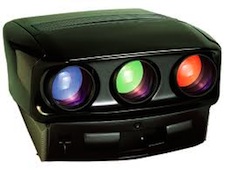It’s the time of year for saving money!
 Some vintage electronics are nearly worth their weight in gold while others’ owners have to pay to have them taken away. Why is that?
Some vintage electronics are nearly worth their weight in gold while others’ owners have to pay to have them taken away. Why is that?
Before we look at why’s let me tell you a little story… A manufacturer’s rep visited me recently to check on the set up of their gear. He told me of visiting a hi-end specialty store early one morning and inside the front door was a very clean Vidikron Vision One projector. Now for those who weren’t into high-end video during the late ’90’s, the Vision one was THE CRT projector against which all others were measured, and arguably, the finest CRT projector ever made. Enthusiasts would buy two, and stack them vertically to double the light output. They required care and feeding. Someone (usually an ISF -trained and certified calibrator) would spend hours converging the picture so the two images lined up perfectly. Even a single Vision One needed a regular “touch up” calibration to keep everything right, making it an expensive, high-maintenance projector. But when everything was set up correctly, the Vision One’s picture could look glorious.
Back to the Vision One sitting on the floor, just inside the door. It’s story was simple, the dealer tried to sell it with no takers. Even at a ridiculous discount of pennies on the dollar, no one wanted it. Why? Because for the amount of time and effort required to install and set up the Vision One, even with deep discount wasn’t worth it anymore. Even hardcore video fanatics have by and large abandoned CRTs because of the constant attention they require to work optimally, limited brightness, and lack of current-gen HDMI input options. And then there’s the image quality of current generation displays. In short the Vision One’s time has come and gone.
So why was the Vision One sitting near the front door? You’ve probably guessed by now – it was waiting for the local scrap hauler to take it away for recycling. Such is the fate of even the finest gear when it becomes functionally obsolete.
Sometimes gear can become technically obsolete yet still maintains a good part of its monetary value because it retains its functional value. The Meridian 500 series gear is a good example of this phenomenon. A 568 pre/pro still goes for over $1000 while most pre/pros of similar vintage don’t command anything near four figures. That’s because the 568 still serves as an excellent sounding audio-only pre-pro that supports up to 96/24 digital files. I currently use a 568.2, with a Sooloos Control 15 tethered to it.
So what’s my point? Simply if you wish to maximize the value of your “investment” in audio gear you have to periodically take a hard look at your system and occasionally take a proactive approach to updating individual components. I’m not advocating selling a component just because a manufacturer runs an ad you dislike, but when it’s obvious a technology has reached the end of its useful life (CDs?), you should probably consider how much you want to bury in a disc-spinner, given that its resale value is almost guaranteed to drop like a rock. Or perhaps it’s finally time to BUY that last great beautifully made CD player before it gets discontinued? It’s your decision to make, but unless you take periodic stock of your system, you’re likely to wake up one morning with a phone-call to a scrap hauler on your to-do list.






i used to adjust my Dwin CRT weekly! My kids used to say, “daddy we don’t like this game”
When I finally gave up trying to find it a good home, it went on the trash pile. The JVC never needs adjusting, so I don’t lose sleep. The Vision One was awesome in its day (especially stacked pairs for $100,000!), but other than nostalgia or any pressing need to heat a room by indirect means, I wouldn’t want a Vision One even for free.
These days, HDMI input cards are available for most CRT projectors. Coupled with performance oriented circuit modifications offered by a few specialist experts, the image that can be delivered by a top notch CRT projector TODAY in 2016 is STILL among the best in the world. Your digitals may be brighter, they may offer a larger screen, but they don’t offer a picture that looks more like YOU ARE THERE than CRT at its best.
Incidentally, the Vision One is a box stock Electrohome Marquee 9500LC. A good machine, but there are better machines that have been made, when it comes to their “as delivered” performance. But the Marquee chassis is the most upgradable and at its best, it is the image quality king. You can spend 100 grand on a digital projector and still not have the image quality I enjoy every time I turn on my own heavily modified 9500LC.
The death of the CRT projector is greatly exaggerated. It is a myth perpetrated by those who are ignorant and easily dazzled by raw brightness, thinking brightness alone equals picture quality. Nothing could be further from the truth.
My projectors might need a very minor tweak twice a year at most. They are stable, as stable as many digitals, and my CRTs will outlast your lamps, many times over.
Well, if they can’t sell it, I can take it off their hands for free the next time I’m in the neighborhood :-).